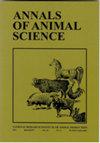Biofloc technology in improving shellfish aquaculture production – a review
IF 1.9
4区 农林科学
Q1 Veterinary
引用次数: 0
Abstract
Abstract Biofloc technology is instrumental in improving growth performance and yield in shellfish aquaculture, while leading to enhanced water quality through maintaining the nutrients level within a safe range. More specifically, toxic nitrogenous wastes are converted into beneficial microbial biomass known as “biofloc”, contributing to improve shellfish immune system. Among the various parameters affecting the efficiency of the process is the carbon source and C:N ratio. In light of these, the present work critically reviews the effects of biofloc systems on growth performance, immunity and diseases resistance in shellfish production. Moreover, it scrutinizes the microbial diversity and nutritional composition of biofloc. Then, the application of the technology in various shellfish cultures, including shrimp, freshwater prawn, crabs, crayfish, clam, and oyster, are presented. Overall, biofloc systems contribute to enhanced shellfish survival rate to the highest value of 96-100% for marine shrimp, 95-99% for freshwater prawn, 70-83% for crayfish, 83-100% for oyster, Crassostrea sp. and up to 2% for mud crabs larvae through substantially reducing the ammonia level in the culture (summarized in table 1- table 5). Finally, the main challenges in utilizing biofloc systems, i.e., suitable aeration and mixing and microbial mechanisms involved are also explained to shed light on future research directions in the field.生物絮团技术在贝类养殖生产中的应用综述
生物絮团技术在提高贝类养殖的生长性能和产量方面发挥着重要作用,同时通过将营养水平维持在安全范围内来改善水质。更具体地说,有毒的含氮废物被转化为有益的微生物生物量,称为“生物絮团”,有助于改善贝类免疫系统。影响工艺效率的参数有碳源和碳氮比。鉴于这些,本工作批判性地回顾了生物絮团系统对贝类生产中生长性能、免疫力和抗病能力的影响。此外,它还仔细研究了微生物多样性和生物群落的营养组成。然后,介绍了该技术在各种贝类养殖中的应用,包括虾、淡水对虾、螃蟹、小龙虾、蛤蜊和牡蛎。总体而言,通过大幅降低养殖中的氨含量,生物絮团系统有助于提高贝类的存活率,海洋对虾的存活率最高可达96-100%,淡水对虾的存活率最高可达95-99%,小龙虾的存活率最高可达70-83%,牡蛎和牡蛎的存活率最高可达83-100%,泥蟹的存活率最高可达2%(表1-表5)。并阐述了适宜的曝气和混合以及所涉及的微生物机制,对该领域未来的研究方向进行了展望。
本文章由计算机程序翻译,如有差异,请以英文原文为准。
求助全文
约1分钟内获得全文
求助全文
来源期刊

Annals of Animal Science
AGRICULTURE, DAIRY & ANIMAL SCIENCE-
CiteScore
3.80
自引率
5.30%
发文量
138
期刊介绍:
Annals of Animal Science accepts original papers and reviews from the different topics of animal science: genetic and farm animal breeding, the biology, physiology and reproduction of animals, animal nutrition and feedstuffs, environment, hygiene and animal production technology, quality of animal origin products, economics and the organization of animal production.
 求助内容:
求助内容: 应助结果提醒方式:
应助结果提醒方式:


